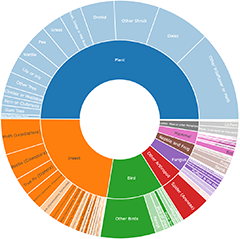Fruitbody walls break away to expose the spores
In a mature fruitbody of a fungus in this sub-group you find powdery spores held within a skin of some sort and the skin breaks up into pieces that fall away to expose the spores. The major genera in this group are Calvatia and Pisolithus.
Within the flexible outer skin of a mature Calvatia fruitbody the spores are held within a bundle of entangled filaments (much like a wad of cotton-wool). At maturity the fruitbody is fairly soft and the skin breaks into polygonal fragments that fall away to expose the spores and ‘cotton wool’ interior. In some species, the fragments fall off fairly quickly but in others slowly and, before the fragments fall away, you can see polygonal cracking over the whole surface of the intact fruitbody. The fruitbodies range from spherical to pear-shaped and from a few centimetres to well over 30 centimetres in breadth. Initially the fruitbodies are usually white but may become shades of lilac or brown at maturity.
In Pisolithus the mature fruitbody is fairly firm, the skin thin and brittle. Initially you find a layer of powdery spores above a non-powdery region that (when viewed in cross-section) is a mottled mix of numerous rice-grain sized cells (peridioles) in shades of yellow, brown and black. The exterior may be of the same colours or white. Over time, more and more spores are maturing lower down (within the peridioles) as more and more free, mature spores in the upper region are being blown away. In effect, spores mature in waves, from the top down, and as they mature skin breaks into small fragments (much like brittle, flaky pastry) which fall away to expose the mature spores. Fruitbodies range from a centimetre or so to over 10 centimetres in breadth. A wall separates each peridiole from its neighbours. You could think of each peridiole as a mini fruitbody and the whole Pisolithus fruitbody as a community of such mini fruitbodies.
Arachnion: The fruitbodies range from 5 to 20 millimetres in diameter, have a thin, fragile skin with the interior looking as though it is filled with peridioles the size of sand grains. The fruitbody is white to yellowish or khaki shades. It has been found once in the local area, on the eastern slopes of Black Mountain. The peridioles in that collection are about a quarter of a millimetre in diameter.
Announcements
There are currently no announcements.
Discussion
Pisolithus sp.
Pisolithus sp.
Calvatia cyathiformis
Pisolithus sp.
Top contributors
- trevorpreston 22
- Teresa 12
- Mike 12
- AaronClausen 8
- JackyF 7
- Jennybach 7
- Paul4K 6
- AlisonMilton 6
- Heino1 6
- MartinPredavec 6
Top moderators
- Heino1 100
- Heinol 30
- Heino 29
- MichaelMulvaney 20
- Teresa 13
- JTran 10
- CanberraFungiGroup 9
- KenT 8
- Pam 6
- Csteele4 6




